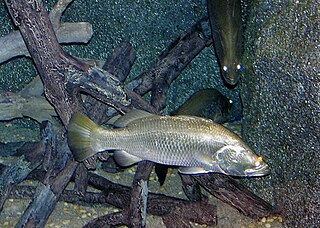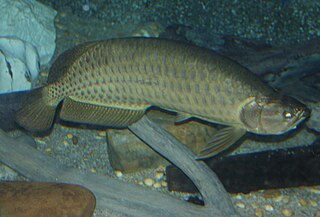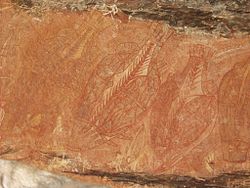Bass is a generic common name shared by many species of ray-finned fish from the large clade Percomorpha, mainly belonging to the orders Perciformes and Moroniformes, encompassing both freshwater and marine species. The word bass comes from Middle English bars, meaning "perch", despite that none of the commonly referred bass species belong to the perch family Percidae.
Sea bass is a common name for a variety of different species of marine fish. Many fish species of various families have been called sea bass.

The Eurasian carp or European carp, widely known as the common carp, is a widespread freshwater fish of eutrophic waters in lakes and large rivers in Europe and Asia. The native wild populations are considered vulnerable to extinction by the International Union for Conservation of Nature (IUCN), but the species has also been domesticated and introduced into environments worldwide, and is often considered a destructive invasive species, being included in the list of the world's 100 worst invasive species. It gives its name to the carp family, Cyprinidae.

The Nile perch, also known as the African snook, Goliath perch, African barramundi, Goliath barramundi, Giant lates or the Victoria perch, is a species of freshwater fish in family Latidae of order Perciformes. It is widespread throughout much of the Afrotropical realm, being native to the Congo, Nile, Senegal, Niger and Lake Chad, Volta, Lake Turkana, and other river basins. It also occurs in the brackish waters of Lake Maryut in Egypt. The Nile perch is a fish of substantial economic and food-security importance in East Africa. Originally described as Labrus niloticus, among the marine wrasses, the species has also been referred to as Centropomus niloticus. Common names include African snook, Victoria perch, and many local names in various African languages, such as the Luo name mbuta or mputa. In Tanzania, it is called sangara, sankara, or chenku. In Francophone African countries, it is known as capitaine. Its name in the Hausa language is giwan ruwa, meaning "water elephant".

Tilapia is the common name for nearly a hundred species of cichlid fish from the coelotilapine, coptodonine, heterotilapine, oreochromine, pelmatolapiine, and tilapiine tribes, with the economically most important species placed in the Coptodonini and Oreochromini. Tilapia are mainly freshwater fish inhabiting shallow streams, ponds, rivers, and lakes, and less commonly found living in brackish water. Historically, they have been of major importance in artisanal fishing in Africa, and they are of increasing importance in aquaculture and aquaponics. Tilapia can become a problematic invasive species in new warm-water habitats such as Australia, whether deliberately or accidentally introduced, but generally not in temperate climates due to their inability to survive in cold water.

The Asian arowana comprises several phenotypic varieties of freshwater fish distributed geographically across Southeast Asia. While most consider the different varieties to belong to a single species, work by Pouyaud et al. (2003) differentiates these varieties into multiple species. They have several other common names, including Asian bonytongue, dragonfish, and a number of names specific to the different color varieties.

Scleropages jardinii, the Gulf saratoga, Australian bonytongue, Pearl arowana or northern saratoga, is a freshwater bony fish native to Australia and New Guinea, one of two species of fishes sometimes known as Australian arowana, the other being Scleropages leichardti. It has numerous other common names, including northern saratoga, toga and barramundi. It is a member of the subfamily Osteoglossinae, a (basal) teleost group. Its scientific name is sometimes spelled S. jardini.

Lates is a genus of freshwater and euryhaline lates perches belonging to the family Latidae. The generic name is also used as a common name, lates, for many of the species.

The Waigieu seaperch, or Waigeo barramundi, is a species of marine fish in family Latidae of order Perciformes. The only species of genus Psammoperca, it is native to tropical coastal waters from the Bay of Bengal in the South through Indonesia to northern Australia and north through the Philippines and the South China Sea to Japan.

The southern saratoga, also known as the spotted bonytongue, spotted saratoga, or simply saratoga, is a freshwater bony fish native to Australia. It belongs to the subfamily Osteoglossinae, or arowanas, a primitive group of teleosts. Like all arowanas, it is a carnivorous mouthbrooder. Along with the gulf saratoga, the saratoga is also known as the Australian arowana and barramundi, although the latter name is nowadays reserved in Australia for the unrelated Lates calcarifer.

The European seabass, also known as the Branzino, European bass, sea bass, common bass, white bass, capemouth, white salmon, sea perch, white mullet, sea dace or Loup de Mer, is a primarily ocean-going fish native to the waters off Europe's western and southern and Africa's northern coasts, though it can also be found in shallow coastal waters and river mouths during the summer months and late autumn. It is one of only six species in its family, Moronidae, collectively called the temperate basses.

The mangrove red snapper, also known as mangrove jack, grey snapper, creek red bream, Stuart evader, dog bream, purple sea perch, red bream, red perch, red reef bream, river roman, or rock barramundi, is a species of marine ray-finned fish, a snapper belonging to the family Lutjanidae. It has a wide Indo-Pacific range and has recently been recorded in the eastern Mediterranean Sea.

The climbing perch is a species of amphibious freshwater fish in the family Anabantidae. A labyrinth fish native to Far Eastern Asia, the fish inhabits freshwater systems from Pakistan, India, Bangladesh and Sri Lanka in the west, to Southern China in the east, and to Southeast Asia west of the Wallace Line in the south. It is likely that Anabas testudineus is a species complex, with the binomial name applied to what are actually several different species. With further study, populations of this fish may be divided up into separate species and given new names. In Nepalese Terai it is called "Pothiya"

Lake Awoonga was formed on the Boyne River by the dam located 30 km (19 mi) from Gladstone, in Central Queensland, Australia. It is approximately 30 minutes drive from Gladstone, via Benaraby.
Photobacterium damselaesubsp.piscicida is a gram-negative rod-shaped bacterium that causes disease in fish.
Inland saline aquaculture is the farming or culture of aquatic animals and plants using inland sources of saline groundwater rather than the more common coastal aquaculture methods. As a side benefit, it can be used to reduce the amount of salt in underground water tables, leading to an improvement in the surrounding land usage for agriculture. Due to its nature, it is only commercially possible in areas that have large reserves of saline groundwater, such as Australia.

Aquaculture in Australia is the country's fastest-growing primary industry, accounting for 34% of the total gross value of production of seafood. 10 species of fish are farmed in Australia, and production is dominated by southern bluefin tuna, Atlantic salmon and barramundi. Mud crabs have also been cultivated in Australia for many years, sometimes leading to over-exploitation. Traditionally, this aquaculture was limited to table oysters and pearls, but since the early 1970s, there has been significant research and commercial development of other forms of aquaculture, including finfish, crustaceans, and molluscs.
Barramundi is a saltwater fish of the Indian and western Pacific oceans also called the Asian sea bass. Barramundi, meaning "large-scaled river fish", may also refer to:
The Department of Fisheries, also referred to as the Fisheries Department, is a department overseen by the Ministry of Primary Resources and Tourism (MPRT). The country's fisheries authority is the Department of Fisheries under the MPRT.

















